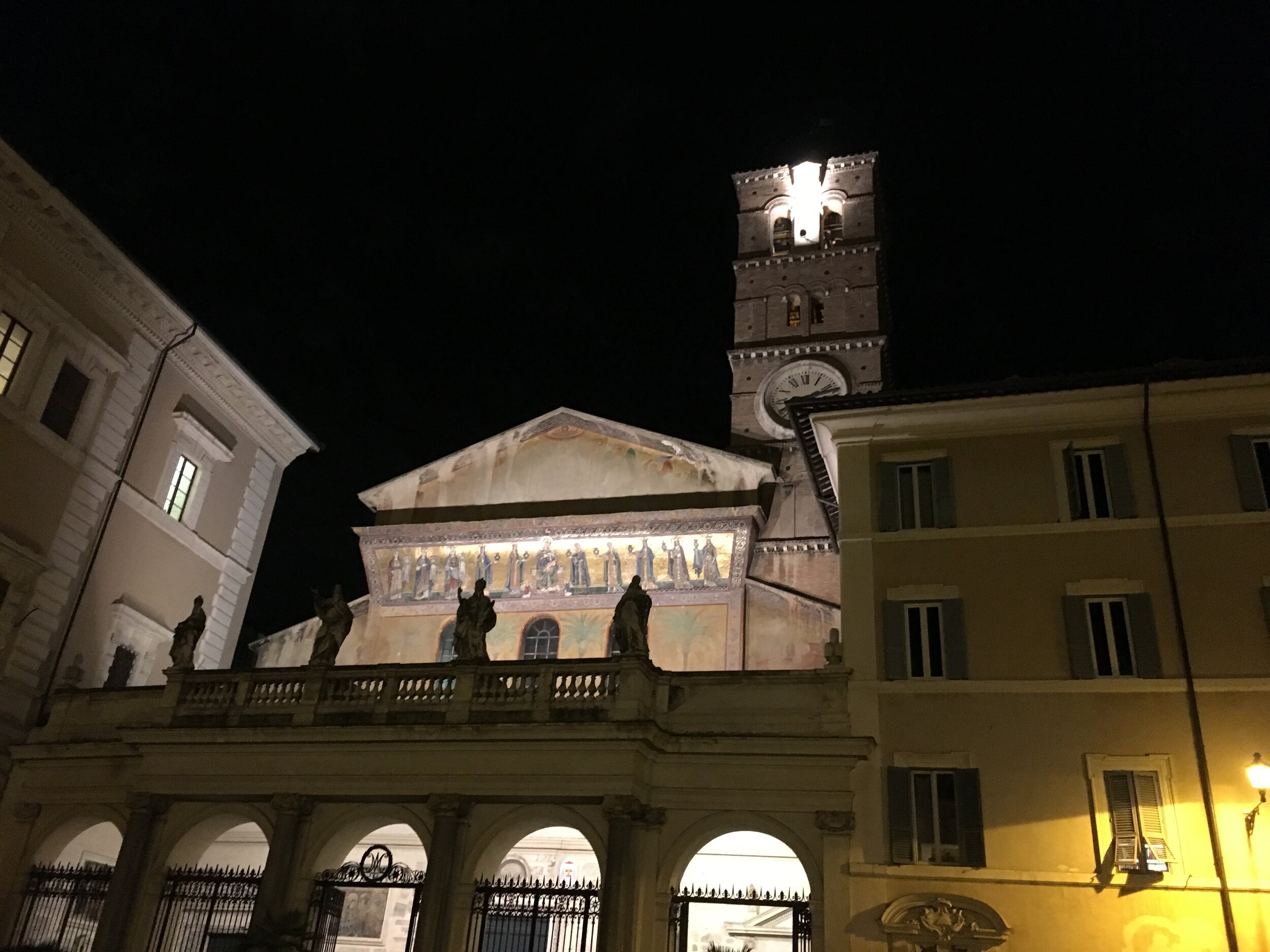Spot in Rome-Santa Maria in Trastevere
Alas, this post is about my favorite church in Rome. I have described bars and restaurants dotted around the vicinity of this church and piazza; San Calisto is a stone’s throw, Ma Che and Freni e Frizioni are nearby, that is, a walk through the scenic Trasteverine streets, as is the restaurant Z’ Umberto. This church and piazza spoke to me when I visited Rome for the first time at 18 years old. I passed through the piazza on a guided walking tour, and the following day my sole (and soul) desire was to return to this place; the name ‘Trastevere’ I butchered in many unrecognizable ways in trying to communicate where I wanted to go to a cab driver, but I made it back. This place holds an unparalleled power over me. Now as a high school teacher, I cringe a little bit thinking about letting students get into taxis on a school trip in a foreign country. Still, I made it back to the piazza at 18 years old and every time I return, I am overwhelmed with the same sense of awe and euphoria even though I have walked through this piazza many, many times. It sounds cliché and exaggerated, I know. I encourage you to experience it for yourselves.
On to some history. As Trastevere is one of the oldest neighborhoods in Rome, it is home to some of the oldest landmarks, including this church. During the earliest period in Rome’s history, the so-called Regal period, when Rome was ruled by kings, the area was controlled by the Etruscans. ‘Rome’ gained control of the right bank by the time that it became a Republic (509 BCE), but this area was truly a hub for immigrants. In particular, Jews and Syrians made Trastevere their home. In fact, the first synagogue, built in 980 CE, is located just across from the first Trastevere apartment I lived in at Vicolo dell’Atleta 14 . Interestingly, the Trastevere area is still one of the most ‘multicultural’ neighborhoods in Rome and a home for immigrants and expats, although now much of the population frequent the multiple American universities in the area and sound like me. In fact, sometimes the amount of English heard in these parts can be a distraction from the beauty of the place, but the greater beauty of Trastevere is, if you turn a corner, you can almost always evade crowds and find a vicolo (alley) to commune with the spirit of the space.
Back to the church, now that we have established Trastevere as a pre-Roman and multiethnic hub over 500 years prior to the birth of Jesus Christ, I will add that the first foundations for the church were established between 221 and 227 CE, and completed in the 4th century CE, and they were related to a legend about the coming of a messiah. These foundations were in the form of the common Ecclesia Domestica, or home church; they were laid by St. Callixtus, who was elected Pope, although a rival, named Hippolytus, was also named pope contemporaneously, starting the long and unfortunate traditional of having popes and antipopes in the history of the Catholic church. Read more about the history of Antipopes here. Callixtus was compelled to build a ‘church’ on this spot because, as the story goes, centuries before, there was a taberna meritoria, or club for the veterans of the Roman army, and they noticed a novel ‘oily substance’ spouting from the ground. This appearance was taken as a miracle and prophesy for the coming of the messiah. Thus, Callixtus made his claim for building this ‘home church’ dedicated to the miracle of the oil, in honor of the coming of Jesus Christ. Read more on page 553 of The Rome Guide. The church, as we see it today, that is, in basilica form, was built in the 12th century. Santa Maria in Trastevere is the first church to have been dedicated to the Virgin Mary.
As for the striking decorations, on the exterior you will notice four statues that are from the 18th century, but the impressive mosaic featuring the Madonna and child in the middle is medieval. There were additions in the 14th and 15th centuries and if you look closely, you will notice the diverse artistic styles of figures on the far right and left. The bell tower is from the 12th century.
You can observe the details while sitting on the polygonal fountain in the middle of the piazza; notably, it was restored by the famous Carlo Fontana in the 17th century, but it has gone through many restorations since at least the early 15th century.
Inside of the church is more beautiful conflation of styles and additions over multiple centuries. The golden ceiling was designed by Domenichino in the 17th century, but the apse mosaic that will captivate your attention upon entry is from the mid-12th century, and it was created in a characteristically Byzantine style.
The church is free to enter and should be open (barring special events and masses) from 7.30 AM to 9 PM.



